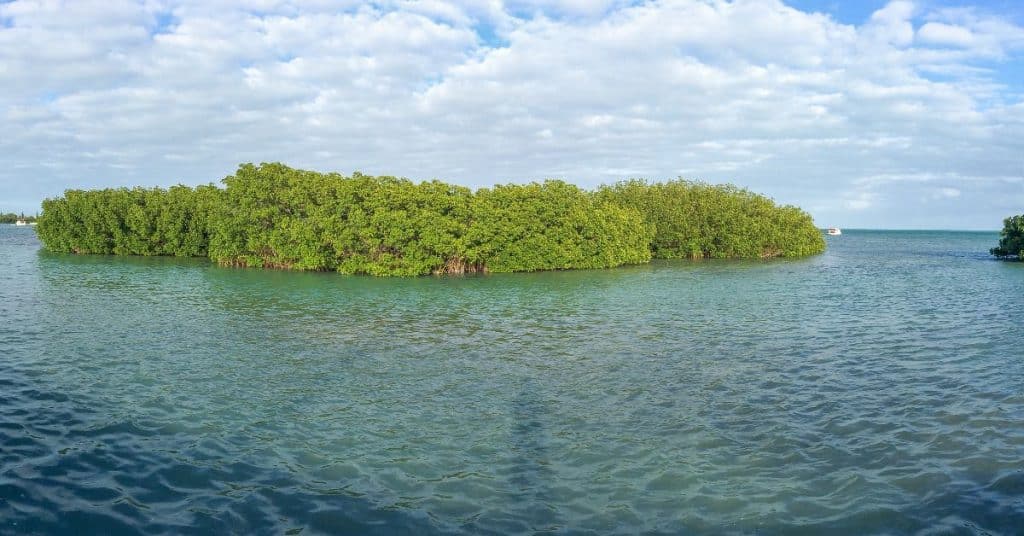Mangroves in Key West are the coastal cool cats that strut their stuff along the shoreline, flaunting their roots and thriving in the brackish waters.
Brackish water is a perfect mix of salty sea water and fresh water, creating a haven for diverse aquatic life.
As I paddled through their waterways, I couldn’t help but feel like I’d stumbled upon nature’s own secret hideaway.
Exploring Mangroves In Key West

Nestled in the heart of the Florida Keys, Key West beckons with its enchanting mangroves—a haven of lush greenery and marine wonders. To unlock the secrets of this coastal paradise, we’ve curated a list of activities that promise to immerse you in the mangrove magic like never before.
Kayak The Mangroves in Key West
Kayaking Key West mangroves by Flourish Ever After
Mangroves are best navigated by kayak because motor-propelled boats cannot do that to narrow, shallow channels created by their laterally spreading roots. Kayak through narrow waterways of mangroves for an unanticipated island adventure.
If you want to know more about Key West’s natural heritage, just hire a kayak for a half or full-day excursion or sign up for a guided tour. For your kayaking adventure in Key West mangroves, we can recommend these companies and tours:
- Lazy Dog Adventures
- Key West Eco Tours
- Paddle The Florida Keys
- Blue Planet Kayak Eco-Tours
- Night Kayak Key West
Pro Tip: Make sure to book your Key West mangrove tour during the morning of a high tide. The experience is not the same in the afternoon during low tide.
Paddleboarding in Key West Mangroves
Paddleboarding through Key West mangroves by Key West Fishing
If you’re looking for a more hands-on approach, grab a paddle and hop on a paddleboard.
Stand tall on your board as you navigate winding channels, marveling at the kaleidoscope of marine life below.
It’s a balancing act of nature and adventure, and who knows—you might even spot a manatee or two casually gliding by.
Snorkeling in the Key West Mangroves
Exploring ancient mangrove tunnels by Key West Waterman
If you have brought your own snorkeling gear or are planning to rent some for your mangrove exploration, then get ready to see the underwater wonders of mangroves in Key West.
The mangroves serve as a nursery for a myriad of marine life, making snorkeling here a captivating experience.
Float over seagrass beds, spy on colorful fish darting between the roots, and marvel at the intricate ballet of underwater flora.
It’s like snorkeling in a living, breathing aquarium!
Discover hidden-gem beaches, explore the Florida Keys food scene, find the perfect accommodation, experience the Keys’ stunning waters, and much more.
What You Can Expect to See Around Key West Mangroves
When exploring the mangroves in Key West, you should be on the lookout for distinctive animals. Both above and below water, activity can be found in the branches and roots of the mangroves.
Here are the different species that you can expect to see around Key West mangroves:
Key Deer
I think the most expected animal to be seen around the mangroves in Key West is the Key Deer. Key deer are a subspecies of white-tailed deer found only in Key West. Their main hue is grayish- or reddish-brown, and they may weigh up to 75 pounds. Their shoulder length ranges from 24 to 32 inches.
These deer, formerly inhabited the lower Key West region, now only inhabit 20–25 islands, ranging from Sugarloaf Key to Bahia Honda Key. They inhabit various environments in Key West, although they primarily eat thatch palm berries and mangrove trees.
They are commonly spotted swimming between islands or meandering through the narrow mangrove creeks as they search for food.
Birds
Key West’s mangroves are home to a wide variety of bird species. The mangroves’ exposed mudflats and shallow water provide an ideal environment for shoreline-probing birds such as sandpipers and plovers.
Key West mangrove creeks are home to wading birds with long, spindly legs that take advantage of the deeper waters. When you are paddling your kayak across the calm waters, you might see some of the following wading birds:
- Herons
- Egrets
- Bitterns
- Spoonbills
- Limpkins
- Ibis
When exploring Key West mangroves, you will see over 29 kinds of ducks, grebes, loons, cormorants, and gallinules. While some of these bird species spend the entire year in Key West, others visit the area only as part of their winter migration. Here are some of the species you might come across:
- Brown Pelican
- Double-Crested Cormorant
- Lesser Scaup
- Purple Gallinule
Fish Species
Many marine animals use the Key West mangrove root systems as a safe refuge to gather food and protection from predators because they maintain the shoreline and prevent erosion.
While on your excursion, you may come across a few of the following aquatic animals:
- Amphipods
- Shrimp
- Sponges
- Sea Stars
- Crabs
- Mollusks
- Snails
- Sea Snails
Large marine animals that seek sanctuary in this protected area—such as sea turtles, mudskippers, lemon sharks, and manatees—also swim through Key West waters close to mangrove root systems.
Some Facts About Mangrove Forests

Key West mangrove forests serve as an essential natural refuge for tropical fish and other regional marine species. The characteristic prop root systems of mangroves enable the trees to seem as though they are floating on water stilts.
These intertwining root systems shield the beach from long-term destructive erosion while assisting the trees in withstanding the ebb and flow of the tides. The Key West wetlands in the Florida Keys National Marine Sanctuary are dominated by red, black, and white mangroves, even though there are 80 different species of mangrove trees.
- Red mangroves are typically found growing close to the shoreline at sea level. They have white flowers, reddish-arching aerial roots, and sharp, glossy leaves.
- White mangroves can grow to a minimum height of 40 feet in the sun and are more common in upland areas than red or black ones. Their little yellow flowers are accompanied by white, somewhat smooth bark.
- Black mangroves are found further inland and grow more vertically than red or white mangroves. Their dark bark is typically coated in salt that has fallen from the plant. They yield mangrove honey from their white blooms.
Mangrove forests have been found to have the potential to store over ten times as much carbon as other types of ecosystems. Why does this matter? It facilitates better breathing for us in addition to protecting the environment. A key component of carbon storage is the soil.
A vast array of marine life and other water critters looking for safety from predators and a secure spot to obtain food are also drawn to the sophisticated root systems of these plants. You may observe anything from sea cucumbers to Key Deer when exploring the mangrove tunnels by boat or kayak.
However, the vastness of the shrimp industry threatens mangrove tunnels and forests. Using nets that may cause harm to the ocean floor, shrimpers catch not just shrimp but also other local creatures. Mangroves are also threatened by storm surges, hurricanes, coastal development, agriculture, and climate change.
The Key West mangroves are essential to our ecosystem and marine life. You are welcome to explore the mangroves in Key West and include them in your itinerary for your Florida Keys vacation!
Explore the Mangroves In Key West Today
Whether you plan to kayak, paddleboard, or snorkel plan to explore the mangroves in Key West.
Keep your eyes peeled for the vast array of species that can be found in and around the mangrove tunnels – from the air and root systems underwater and on the water.
But what’s a mangrove adventure without a touch of mystery? As the sun dips below the horizon, casting a warm glow on the mangrove canopy, you might just catch a glimpse of bioluminescent wonders lighting up the water. So you must try mangrove tours at night as well!
Set sail, paddle, snorkel, or camp—whatever your fancy, the mangroves are ready to welcome you with open roots.
Related Articles
Seriously, everyone of any age or ability level can enjoy paddleboarding. That’s why stand-up paddle board rentals in Key West are a must-do!
The Florida Keys are one of the best locations on the planet for bird watching. We’re sharing insider tips and letting you know what birds you’ll see so you can plan for the best Florida Keys birding adventure.
When is the best time to visit Key West? You might be wondering about that while planning your next vacation with friends or family. In this blog post, we’ll break down the different seasons and factors that can help you decide the ideal time to visit Key West.
Mangroves In Key West FAQs
The Florida Keys are home to three main species of mangroves: the Red Mangrove, the Black Mangrove, and the White Mangrove. Each of these mangrove species plays a unique role in the coastal ecosystem, contributing to the biodiversity and resilience of the region.
Yes, you might spot the elusive American crocodile in the mangroves around Key West. While crocodiles tend to prefer brackish and saltwater habitats, encounters are relatively rare. These ancient reptiles add an extra layer of intrigue to the mangrove ecosystem, but fear not—they’re generally more interested in a quiet sunbathing spot than a confrontation with humans.
Mangroves are ecological superheroes in the Florida Keys, providing many benefits. They act as natural storm buffers, protecting the coastline from erosion and reducing the impact of hurricanes. Their complex root systems create a haven for juvenile fish and marine life, supporting the vitality of fisheries. Additionally, mangroves contribute to water purification and carbon sequestration and offer a rich habitat for diverse flora and fauna.
The biggest danger to mangroves in Florida is human-induced habitat loss and degradation. Urban development, pollution, and alteration of natural water flow are significant threats. Coastal construction and land-use changes can disrupt the delicate balance of mangrove ecosystems. Rising sea levels and climate change also pose challenges, impacting the health and survival of mangroves.






